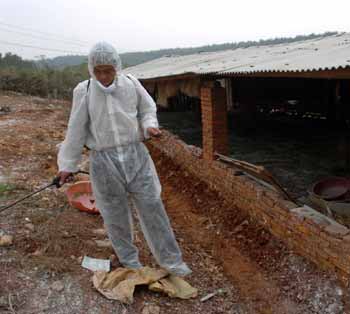|
Take H5N1 seriously, but no need for panic
(HK Edition)
Updated: 2005-11-14 05:48
The world has good reasons to take seriously the spreading cases of
influenza, especially since H5N1 can be fatal, but that doesn't mean we all have
to panic. Prior pandemics, such as those that occurred in 1918, 1957 and 1968,
have demonstrated that when the bird-derived influenza virus enters the human
body, it can adapt to become transmissible among humans themselves. It was
reported, for example, in 1918 that a kitchen staff member of the US Army fell
sick with flu one day, and 500 other soldiers contracted the same illness two
days later. A week later, the flu spread around the US and one month later
became a pandemic affecting the entire world. Forty million people died as a
result.

A Chinese medical worker sprays disinfectant
at a rurual poultry farm in Central China's Hubei Province after a fresh
outbreak of bird flu on Saturday, November 12, 2005.
[Xinhua] | The said rate of the current flu might be overstated. Scientific research
indicates that typical influenza has a reproductive number of two infections per
infection, compared with three in the SARS epidemic, but the flu has a faster
generation time of three days, as opposed to 10 days for SARS. It means that
after 30 days, one flu case will likely have multiplied into 1,024 while one
SARS into 27.
As influenza viruses go, H5N1 is probably the most lethal. Scientists tell us
that influenza viruses are classified according to the protein on their
surfaces. The "H" represents Hemaglutinin protein which causes the virus to
attach to and enter a cell where it replicates, and the "N" refers to
Neuraminidase protein which allows newly replicated copies of the virus to exit
and escape from a cell for further infections. At present, scientists recognize
15 types of H virus and 9 types of N virus. Each combination will form a new
type of bird flu virus subject to further mutation.
Migratory birds have been accused of recently igniting H5N1 epidemics among
domestic poultry throughout Southeast Asia and Central Asia, and among reared
poultry and livestock in developing areas alleged to be responsible for the
spread between poultry and humans. Notwithstanding that human-to-human infection
of H5N1 is not proven yet, human infection cannot be ruled out. The WHO declares
it will only be a matter of time as the virus evolves and mutates.
Albeit H5N1 is dangerous, the mortality ratio of about
60 deaths in 120 cases may also be misleading. Some data of patients who got
H5N1 but recovered later may have not been taken into account, whereas fatal
statistics are more accurately recorded. The fatality ratio should be normally
several per cent of all infected cases, much less than SARS.
|